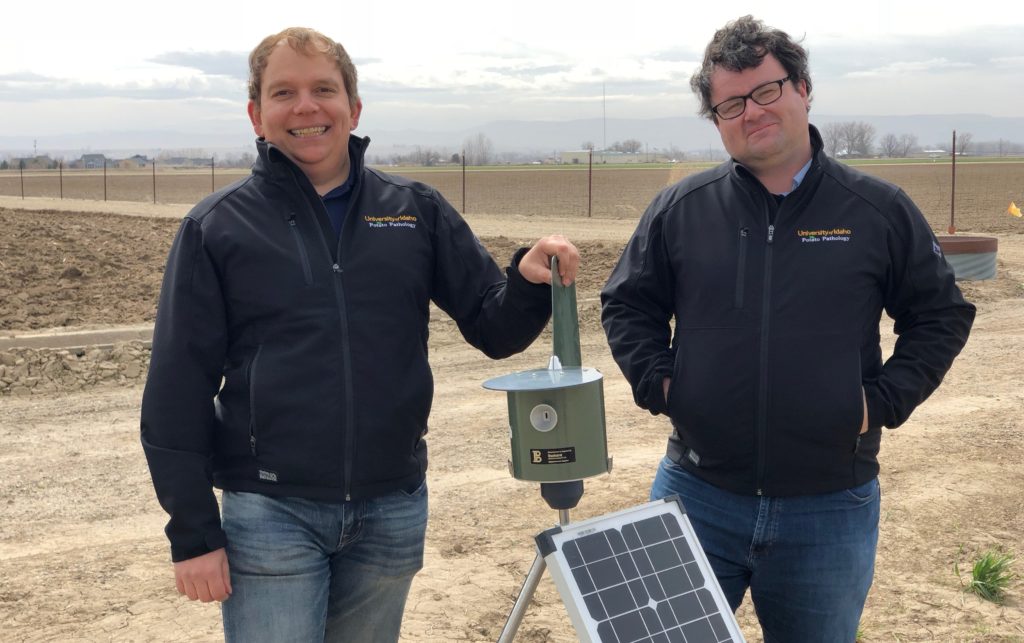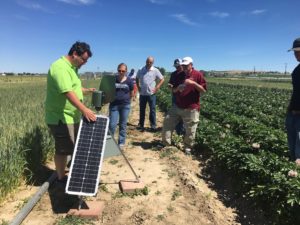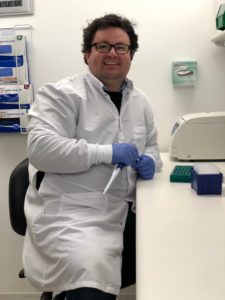
Spore sampling project to alert growers of disease threat
A University of Idaho-led research team plans to start giving their state’s potato growers advanced warnings this season about the arrival of fungal pathogens, using a broad network of airborne spore samplers.
Last summer, James Woodhall, the project’s lead and a University of Idaho (UI) assistant professor of plant pathology, and his colleagues evaluated samples collected by three spore samplers, based at their Parma, Kimberly and Aberdeen Extension centers, to prove the concept.
This growing season, Woodhall said they’ll operate 14 samplers, stationed both at the UI facilities and near commercial potato fields spread from Parma through Tetonia. Woodhall intends to alert growers – initially via an email list and eventually by posting results on a special website – within a day of confirming the arrival of harmful potato pathogens including late blight, early blight, white mold, gray mold and brown spot.
“It’s proven technology,” Woodhall said. “They’ve had success with this in Canada for late blight detection.”

growing season. Photo: Phil Wharton
Woodhall said spores sucked into the machines will be collected weekly and tested for pathogens at his laboratory, using a scientific method known as real-time polymerase chain reaction, which is a DNA-based detection method.
Woodhall expects to complete development of his final disease test, for early blight, before sampling begins in May. He plans to provide growers with data from June through September. Based on his success at detecting pathogens in sugar beets during last season’s trial run, Woodhall hopes to give growers up to two weeks’ notice of the arrival of harmful spores, prior to the first symptoms surfacing in fields.
The researchers hope to soon obtain funding to erect weather stations near samplers and will also take leaf samples from nearby fields, in an effort to determine how weather conditions may affect the risk of crop damage, and how the density of spore samplers may affect the margin of error.

control measures before pathogens become a major problem.
Photo: James Woodhall
“You need to find a way to quantify and make a link between the amount of DNA and disease outbreak. You need to determine what the thresholds are in terms of spore numbers,” said Phil Wharton, a UI associate professor of plant pathology involved in developing the disease-forecasting models. “The potential is to provide close to real-time forecasts for growers for diseases like late blight.”
Woodhall explained spore samplers could be especially important in helping Idaho growers manage for late blight, given that the state’s climate is so arid. In wetter growing areas, Woodhall said late blight spores are ubiquitous, and farmers simply apply fungicide when storms arrive. In Idaho, however, spores aren’t always present when storms arrive, and sampling data could help growers avoid unnecessary spraying. He’s also developing a methodology to more quickly determine the specific late blight strain of his laboratory samples, which should help growers select proper fungicides.
James Hoff, an Idaho Potato Commissioner who farms in Idaho Falls, said fungicides are costly, and several applications are typically needed when disease pressure is high.
“Having that information in a timely fashion is critical,” Hoff said. “This is going to be a good thing.”

Woodhall in the lab.
The Idaho State Department of Agriculture awarded the project a $200,000 USDA block grant to support a post-doctoral researcher. Several state commodity groups have supported the project by funding spore samplers, and Woodhall has also developed tests to detect pathogens affecting wheat, barley, onions and sugar beets. He also sees potential for the network to help Idaho’s grape and hop farmers.
The potato industry has been especially enthusiastic about the network. Major potato processors and growers collectively donated about $80,000 toward purchasing samplers, and the Northwest Potato Research Consortium contributed $16,000 toward sample collections and maintaining the network.
“This whole thing has moved much quicker than I expected, and I think the key is we had the Idaho Potato Commission and industry and the university all aligned together,” Woodhall said.
The consortium, which invests in potato research on behalf of the potato commissions in Idaho, Washington and Oregon, will almost certainly fund the project again in the upcoming fiscal year, said its director, Andy Jensen.
“The industry is so supportive of it,” Jensen said. “In general, predicting when a disease is going to be there is very difficult or impossible. You have to wait to see it in the field or prevent it from colonizing a field in the first place.”







